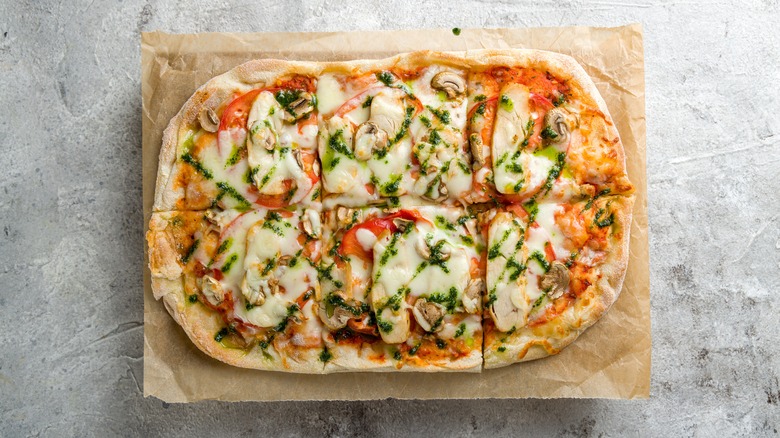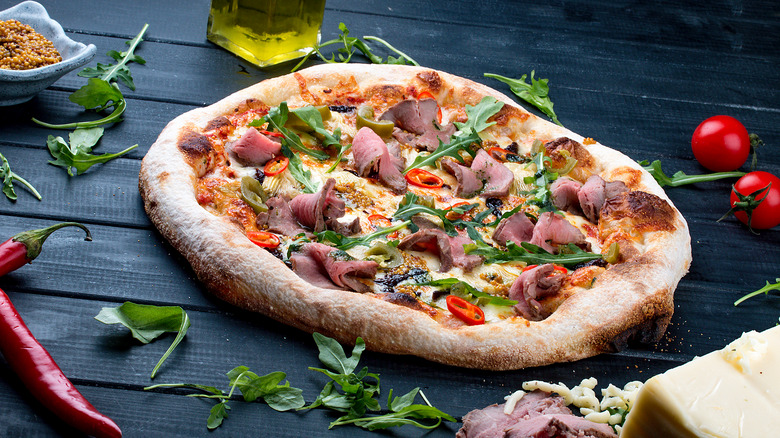What Makes Rome's Pinsa Flatbread Unique?
When you think of indulging in pizza in Southern Italy, a classic Neapolitan pizza probably comes to mind. The country's perfectly puffed, fire-blistered crust with a crunchy textured dough, holding in robust tomato sauce and vibrantly-colored toppings truly is the stuff of dreams. While the Neapolitan pizza has become iconic around the globe, Italian flatbreads are no less magical and healthier to boot.
Specifically, the crispy Roman pinsa may be the reigning champ of pizza-adjacent dishes. Aside from the visual differences (pinsa being more oval than round), flatbread is often considered a healthier and tastier version of pizza, owing to the differences in ingredients and preparation.
The process for making pinsa includes a long fermentation period and lower baking temperatures, which creates a delectably airy dough and complex flavor profile. Add to that a low-fat, low-carb ingredients list, and it may be worth putting this Roman classic into your dinnertime rotation.
History of pinsa
The exact origins of pinsa are unknown, and it's even debated whether the flatbread is an ancient or modern creation. Many, like Basil & Grape, have concluded that the first pinsas were made around 600 years ago. According to Italian Recipe Book, poverty-stricken farmers were the first to have made pinsa dough from a mix of water and various cereal grains. The site references the ancient poet Virgil, who made note of the Roman peasants' herby oval-shaped dough baked over coals. According to Basil & Grape, the flatbread was even considered good enough to be an offering to the Roman gods.
However, the rekindled fame of pinsa flatbread in the modern era has caused speculation about the dish's real origins. Italian Recipe Book notes that in 2001, Corrado Di Marco and his family became famous for their pinsa flatbread. Di Marco is reported to have said in an interview that the story of it being an old Roman dish was made up to sell more pinsa. And there may be some truth to this, as Romans were unfamiliar with the name pinsa prior to 2001.
Regardless, pinsa has remained a popular dish that has garnered fame overseas for its superior flavor and healthier qualities, per Pinsa Romana.
Ingredients in pinsa
Italian Recipe Book says a typical pinsa is made with three different types of flour: wheat, rice, and soy flour, and a light application of carefully selected toppings. Fine Dining Lovers' recipe calls for bread flour, white rice flour, and soy flour, along with active dry yeast, water, fine sea salt, and extra-virgin olive oil.
Basil & Grape notes that this lineup of simple and healthy ingredients (with less starch, gluten, sugar, and fat than typical pizza) allows pinsa to be a much healthier alternative to traditional pizza.
Aside from just the ingredients, another reason pinsa is so healthy is that it is very easy to digest. The dough is well hydrated, which, the site notes, "helps the food naturally pass through the digestive system faster." Similarly, its long fermentation process (up to 72 hours) breaks down the sugars, proteins, and starches in the dough, also allowing for easier digestion.
How pinsa flatbread is made and eaten
The name pinsa comes from the Latin word for "to press," pinsere, alluding to how the delicious, crispy crust is made (via Pinsa Romana). The dough must be hand-pressed rather than worked with a machine, which the site notes, keeps the fermented gases within the dough. This process allows the finished dough to be light and airy with a complex flavor.
Pinsa dough is much wetter than pizza dough, yielding a lush, rather than dry crust. Additionally, the dough is shaped on a surface, as opposed to spun in the air like pizza. The final result is lower in calories, fat, and salt than pizza, making it a healthier choice. Although, the toppings do play a role as well. If you want to top the flatbread traditionally, you can go for a classic blend of tomato sauce, mozzarella, and an herb, like basil or oregano, as per Fine Dining Lovers. However, it is completely customizable and creativity is always encouraged.
Pair it with a glass of wine and you can get the full Mediterranean experience right from your kitchen.



